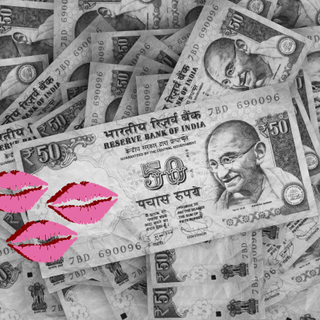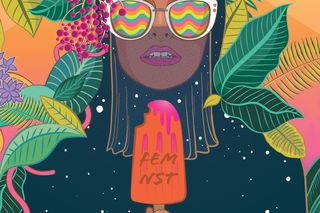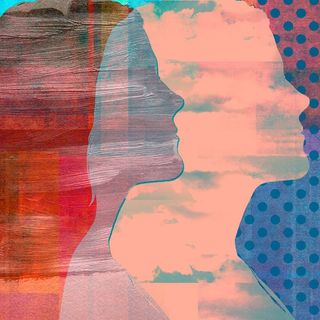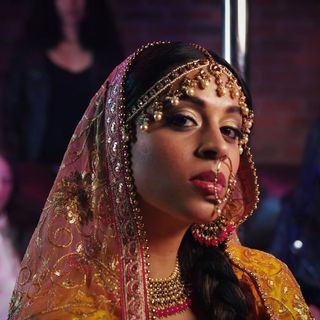
Sabyn Javeri on ‘Hijabistan’ and the Veil as a Metaphor
“As a story teller I’m interested in the stories we want to hide — the ones we don’t want anyone else to know.”

From a kleptomaniac who uses her abaya to steal lipsticks and flash men, to a British Asian woman drawn into the jihad in Syria, Sabyn Javeri’s short story collection, Hijabistan, is a rebuke and revelation of what a Muslim woman is and can be. In conversation, Javeri talks about the concept of a ‘Hijabistan,’ the things women are and aren’t allowed to be, and the surprising reception her book has gotten. This interview has been edited for length and clarity.
The Swaddle: Can you tell us a little about yourself and what made you become a writer?
Sabyn Javeri: I’m quirky, creative and usually see the world upside down. Jokes aside, I’m a mother, academic, writer, wife, working woman in that order. I grew up as a lonely child during an Islamic military dictatorship devouring books completely inappropriate for my age and I think somewhere deep inside that sowed the seeds of writing in me. Growing up in a postcolonial dictatorial society, I felt no one was telling my story in the books by Austen and Orwell that we were made to study in school. Public libraries were almost non-existent; so was a robust publishing industry, thanks to state censorship. In such a situation I felt if I wanted my story be to be heard, I would have to tell it myself. After marriage, when I moved to a foreign land, it was the same story. The urgency to write a counter narrative to the exotic and mysterious ‘orient’ seemed all the more necessary. I guess that’s what made me want to be a writer.
The Swaddle: Can you talk a bit about the title — why ‘Hijabistan’? In the book, the hijab comes to function as much more than a physical veil. How would you say we might reexamine metaphorical veils in our lives?
SJ: To me Hijab means to veil, to hide. As a storyteller, I’m interested in the stories we want to hide — the ones we don’t want anyone else to know. For me, hijab is not a piece of cloth we put on our heads, but the veil we put on our thoughts, desires and needs. For me, the meaning of hijab is self-censorship, and that’s what I wanted to explore in this book. The metaphorical interpretation of hijab — land of the veiled.
By the metaphorical hijab I mean the curtain over our desires and wants, the divider between us and them, men and women, women and women. I always say that there are stories we tell others, and then there are stories we tell ourselves, and then there are yet again stories we want to hide, never acknowledge, even to our own selves. It is those stories that I want to lift the veil on. Those are the veils we need to examine in our lives.
They call out the fact that we put women on a spectrum of good girl and bad girl, with no room for in-between.
The Swaddle: Did you write all the short stories with this central theme of the hijab in mind? What are we getting wrong about the hijab and what it might mean for women?
SJ: Not all the stories were written with the theme of Hijab in mind in this collection, as it includes many of my older stories. It’s when I was collating the collection that I realized the hijab, or my fascination with it as an enabler or an oppressor, has been present throughout my journey as a writer. I have always been fascinated with how we relate the hijab with piety, though different women have different reasons for wearing. And we automatically assume that a women who does not take the hijab will be modern or non-religious. These binaries have always fascinated me. The idea of boxing people according to their religious identity has been present in much of my earlier work as well. So, I thought I should include those works that reflect the theme of the veil as a metaphor for suppression.
I’m interested in looking beyond the obvious. When I first started writing these stories, they were about strong, heroic women who wore the hijab, but I soon realized that was not a story I wanted to tell. I was more interested in the stories they were hiding, the ones they didn’t want anyone to find out. And there were so many of them. So many layers to what was covered by a simple physical garment. It was this metaphorical hijab that I wanted to explore.
Related on The Swaddle:
Author Chitra Banerjee Divakaruni on the Value of Epics in the #MeToo Era
The Swaddle: In each of these stories, a certain idea of women, especially Muslim women, is shattered. The characters very easily shrug off the double-bind of the Madonna-whore complex, which is so refreshing to read. But do you feel like they’re still trapped within the societal confines of marriage/motherhood/family? The patriarchy is a difficult system to escape, no?
SJ: You can only shatter it, if a stereotype exists. Just like all Muslims are not terrorists, and all terrorists are not Muslims, all Muslim women can’t be boxed into a single category by their appearance. Many readers on social media are agitated that this has not turned out to be a collection of strong, empowered women who are changing the world in a hijab. It is that. But it also something more.
There are stories here that are inspiring and uplifting — like “Coach Annie,” “Fifty Shades at Fifty,” “The Flyover,” “The Good Wife” — but there are also others which are darker and somewhat sinister. There are stories which discuss sexuality, promiscuity and the idea of piety not being defined by appearance. They challenge one’s internalized patriarchy; they make you question your own prejudice. They call out the fact that we put women on a spectrum of good girl and bad girl (goddess or whore/saint or sinner/heroine or vamp) with no room for in-between. If you dress a certain way and behave in a certain manner, you are good girl, and if you don’t, you are a bad girl. The darker stories challenge that notion, and I’m not surprised that many are angry because no one wants to admit that subconsciously, we are endorsing patriarchy and misogyny.
The Swaddle: Hijabistan is your second book after your debut novel, Nobody Killed Her. What was it like switching from a political thriller back to short story writing? Is there something about the genre that allows you to flex different kinds of skills as a writer, or impact readers in a different way?
SJ: Writing a novel gives you way more freedom to explore a topic at length. With short stories, of course, you have to be more focused. They are about a particular moment, a snapshot, a glimpse in time, as you don’t have the space to develop a character arc or plot. It’s definitely more challenging. But then again, it is a form I love. It gives me a chance to experiment with craft and also suits my busy lifestyle, because at this moment in my life I don’t have the time or space for the continuity that a novel requires. I write my short stories in small burst of unexpected time. Mostly if I happen to wake up in the middle of the night and can’t get back to sleep.
Some people say that short stories have less impact than a novel, but I don’t feel that way. I feel if a story touches your heart, length has little to do with it.
What’s been shocking is that women in Pakistan, even those who do purdah, have loved it, while many of those who I considered progressive and liberal have rejected it.
The Swaddle: The stories in the book center different women, at different ages, living in vastly different geo-political contexts, from a 50-year-old Parsi couple in Karachi, to a young British-Muslim girl in Syria. Both within the sub-continent and in the diaspora, you seem to have touched on very relevant issues. How much have your experiences informed your insights into each character’s lives?
SJ: I think something has to touch you personally for you to feel strongly about it. In that sense, every story has a part of me in it. Because no matter how disconnected you are from the experience you are writing about, your own view and biases do creep in.
I wrote Hijabistan while living in Pakistan, observing everyday life with a microscope. I realized that these purdah-observing women, however oppressed, were not victims, but survivors. There were two sides to a story. The domestic help, the sex workers, no matter how destitute they seemed, were all fiery women who were fighting back. My view of the subaltern changed when I saw them close up, and I knew I had to write about these women who in some way were far more powerful than those born to power and privilege.
I also realized that desire is such a big part of who we are. Whether its an aged woman who is no longer allowed to feel sexual; or a young British Asian who is trying to find her identity as a Muslim either through violence, sexuality or through the hijab; or a housewife who is talented, but suffers from the imposter syndrome because ambition, desire and assertiveness are not encouraged in women — while the same qualities are cherished in men. For me it was important to call out these hypocrisies and, so to speak, life the veil on these desires, which are very much part of female DNA, too.
Related on The Swaddle:
Author Gayatri Rangachari Shah on Women Leading in Male‑Dominated Bollywood
The Swaddle: Considering how rare it is for a book like yours to come along, where women are allowed to be dark and funny and subversive, without necessarily needing a happy ending or things neatly tied up at the end, I wonder what the reception of Hijabistan has been like. Have you been surprised, pleasantly or otherwise, by its reception?
SJ: Thank you, that’s a great thing for a writer to hear. Readers either hate this book or love it. What’s been shocking is that women in Pakistan, even those who do purdah, have loved it, while many of those who I considered progressive and liberal have rejected it, calling it a concocted fantasy that is not about the hijab as they understand it.
The kind of scrutiny this book has been subjected to has left me flabbergasted. Literary critic Asif Farrukhi recently pointed out that, after Rasheed Jahan wrote about the veil in her story “Visit To Delhi” in the anthology Angarey back in early 1900s, for which she was deemed the ‘bad girl of literature,’ no one else has attempted this topic till I came along. I’m the second South Asian woman writer to do so. And he rightly pointed out “getting the same kind of flak.” What’s fascinating is that 80-90 years later, we are still struggling with the same mindset and not ready to accept women characters who, as you rightly said, “are allowed to be dark and funny and subversive, without necessarily having to get a happy ending or things neatly tied up at the end.”
The Swaddle: If readers had to take just one thing away from this book, what would you like it to be?
SJ: A sense of self. I would like women to realize their right to be who they are. We need to stop questioning ourselves constantly. To just be — without trying to live up constantly to the norms and standards society has set for us. To just breathe. To be free. Answerable only to our own consciousness, like the men around us who live their lives unapologetically.
In the culture we live in, being called ‘career-minded’ or ‘ambitious’ is a slur for women. We feel embarrassed to admit that we might want to be the head of a corporation rather than a mother. Similarly, we are also made to feel bad if we say “I want to be a housewife” or a stay-at-home mother. We are put in a double bind where our choices are constantly questioned. I know it’s not easy, but if my readers can take anything away from this book, I would want it to be a sense of self to be who you are and proud of it.
Nadia Nooreyezdan is The Swaddle's culture editor. Since graduating from Columbia Journalism School, she spends her time thinking about aliens, cyborgs, and social justice sci-fi. She's also working on a memoir about her family's journey from Iran to India.
Related


It’s Time for a More Humane Approach to Mental Health Care
